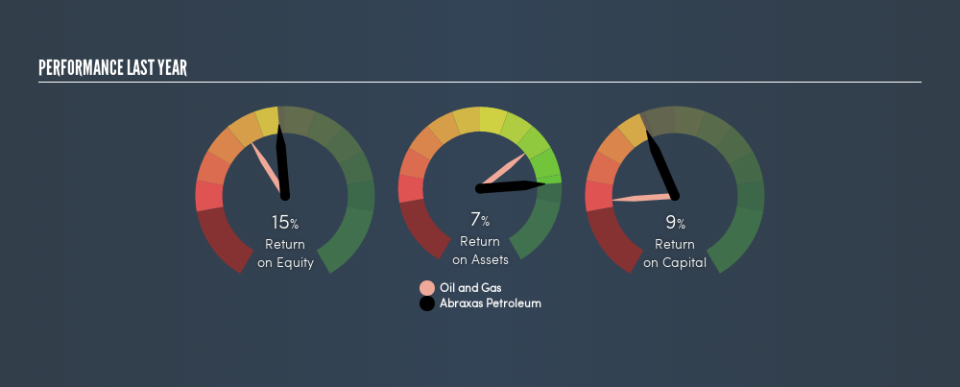Abraxas Petroleum Corporation (NASDAQ:AXAS) Earns Among The Best Returns In Its Industry

Want to participate in a short research study? Help shape the future of investing tools and you could win a $250 gift card!
Today we'll evaluate Abraxas Petroleum Corporation (NASDAQ:AXAS) to determine whether it could have potential as an investment idea. Specifically, we'll consider its Return On Capital Employed (ROCE), since that will give us an insight into how efficiently the business can generate profits from the capital it requires.
Firstly, we'll go over how we calculate ROCE. Second, we'll look at its ROCE compared to similar companies. Then we'll determine how its current liabilities are affecting its ROCE.
Understanding Return On Capital Employed (ROCE)
ROCE is a metric for evaluating how much pre-tax income (in percentage terms) a company earns on the capital invested in its business. All else being equal, a better business will have a higher ROCE. Overall, it is a valuable metric that has its flaws. Author Edwin Whiting says to be careful when comparing the ROCE of different businesses, since 'No two businesses are exactly alike.'
How Do You Calculate Return On Capital Employed?
The formula for calculating the return on capital employed is:
Return on Capital Employed = Earnings Before Interest and Tax (EBIT) ÷ (Total Assets - Current Liabilities)
Or for Abraxas Petroleum:
0.092 = US$31m ÷ (US$415m - US$77m) (Based on the trailing twelve months to March 2019.)
So, Abraxas Petroleum has an ROCE of 9.2%.
View our latest analysis for Abraxas Petroleum
Is Abraxas Petroleum's ROCE Good?
One way to assess ROCE is to compare similar companies. In our analysis, Abraxas Petroleum's ROCE is meaningfully higher than the 7.4% average in the Oil and Gas industry. We consider this a positive sign, because it suggests it uses capital more efficiently than similar companies. Setting aside the industry comparison for now, Abraxas Petroleum's ROCE is mediocre in absolute terms, considering the risk of investing in stocks versus the safety of a bank account. Readers may find more attractive investment prospects elsewhere.
In our analysis, Abraxas Petroleum's ROCE appears to be 9.2%, compared to 3 years ago, when its ROCE was 0.7%. This makes us think about whether the company has been reinvesting shrewdly. You can click on the image below to see (in greater detail) how Abraxas Petroleum's past growth compares to other companies.
When considering ROCE, bear in mind that it reflects the past and does not necessarily predict the future. ROCE can be misleading for companies in cyclical industries, with returns looking impressive during the boom times, but very weak during the busts. ROCE is only a point-in-time measure. We note Abraxas Petroleum could be considered a cyclical business. What happens in the future is pretty important for investors, so we have prepared a free report on analyst forecasts for Abraxas Petroleum.
Do Abraxas Petroleum's Current Liabilities Skew Its ROCE?
Liabilities, such as supplier bills and bank overdrafts, are referred to as current liabilities if they need to be paid within 12 months. Due to the way the ROCE equation works, having large bills due in the near term can make it look as though a company has less capital employed, and thus a higher ROCE than usual. To counteract this, we check if a company has high current liabilities, relative to its total assets.
Abraxas Petroleum has total assets of US$415m and current liabilities of US$77m. Therefore its current liabilities are equivalent to approximately 18% of its total assets. This very reasonable level of current liabilities would not boost the ROCE by much.
Our Take On Abraxas Petroleum's ROCE
If Abraxas Petroleum continues to earn an uninspiring ROCE, there may be better places to invest. You might be able to find a better investment than Abraxas Petroleum. If you want a selection of possible winners, check out this free list of interesting companies that trade on a P/E below 20 (but have proven they can grow earnings).
If you like to buy stocks alongside management, then you might just love this free list of companies. (Hint: insiders have been buying them).
We aim to bring you long-term focused research analysis driven by fundamental data. Note that our analysis may not factor in the latest price-sensitive company announcements or qualitative material.
If you spot an error that warrants correction, please contact the editor at editorial-team@simplywallst.com. This article by Simply Wall St is general in nature. It does not constitute a recommendation to buy or sell any stock, and does not take account of your objectives, or your financial situation. Simply Wall St has no position in the stocks mentioned. Thank you for reading.

 Yahoo Finance
Yahoo Finance 
